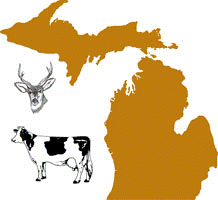Wildlife Disease and Zoonotics
Date of this Version
2008
Abstract
Bovine tuberculosis (TB) is endemic in white-tailed deer (Odocoileus virginianus) in the northeastern portion of Michigan’s Lower Peninsula. Bovine TB in deer and cattle has created immense fi nancial consequences for the livestock industry and hunting public. Surveillance identified coyotes (Canis latrans) as potential bio-accumulators of Mycobacterium bovis, a finding that generated interest in their potential to serve as sentinels for monitoring disease risk. We sampled 175 coyotes in the bovine TB–endemic area. Fifty-eight tested positive, and infection prevalence by county ranged from 19% to 52% (statistical mean 33%, SE 0.07). By contrast, prevalence in deer (n = 3,817) was lower (i.e., 1.49%; Mann-Whitney U4,4 = 14, pM. bovis by 40%. As a result of reduced sampling intensity, sentinel coyote surveys have the potential to be practical indicators of M. bovis presence in wildlife and livestock.



Comments
Published in Emerging Infectious Diseases • www.cdc.gov/eid • Vol. 14, No. 12, December 2008.